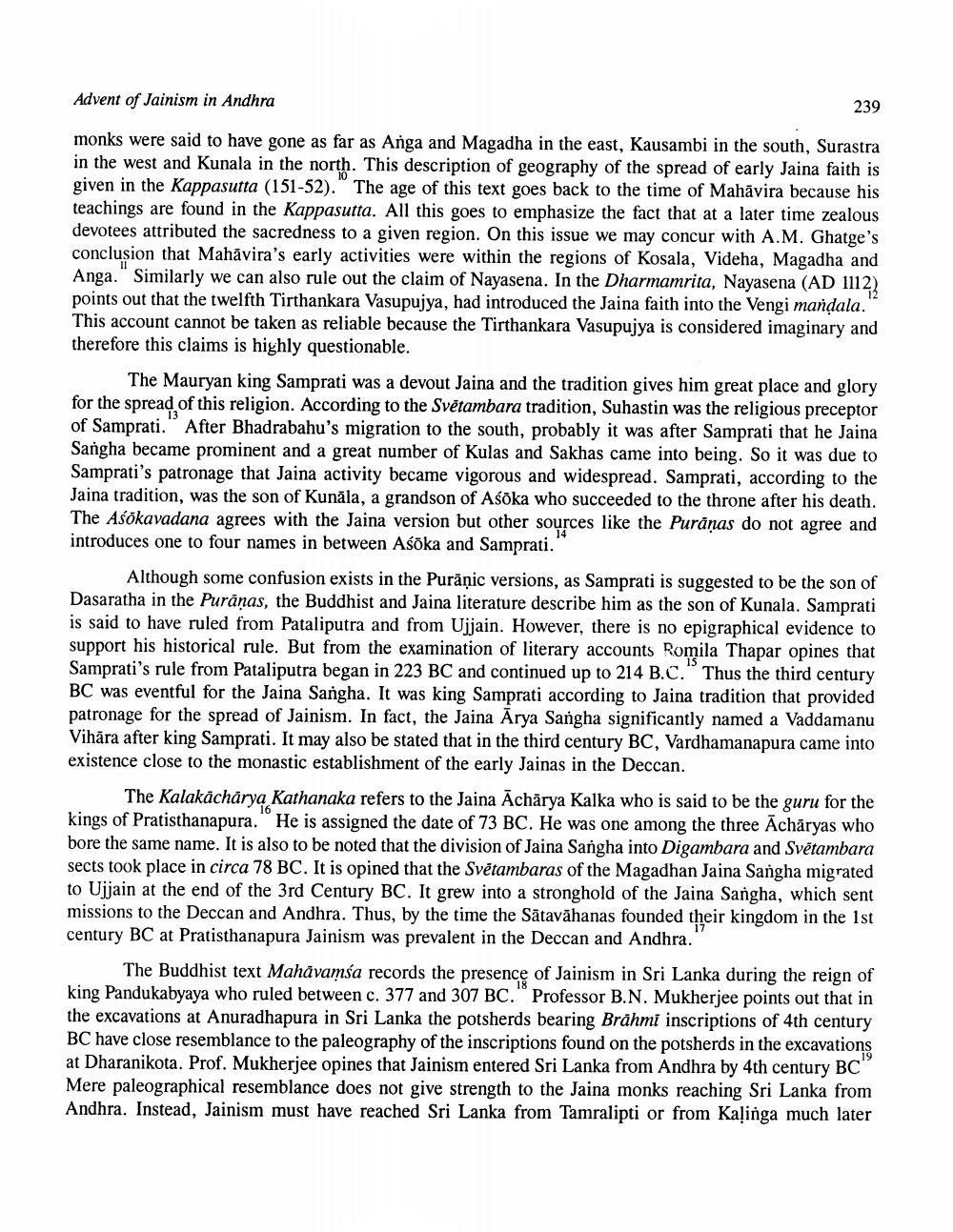________________
Advent of Jainism in Andhra
monks were said to have gone as far as Anga and Magadha in the east, Kausambi in the south, Surastra in the west and Kunala in the north. This description of geography of the spread of early Jaina faith is given in the Kappasutta (151-52)." The age of this text goes back to the time of Mahavira because his teachings are found in the Kappasutta. All this goes to emphasize the fact that at a later time zealous devotees attributed the sacredness to a given region. On this issue we may concur with A.M. Ghatge's conclusion that Mahavira's early activities were within the regions of Kosala, Videha, Magadha and Anga." Similarly we can also rule out the claim of Nayasena. In the Dharmamrita, Nayasena (AD 1112) points out that the twelfth Tirthankara Vasupujya, had introduced the Jaina faith into the Vengi mandala. This account cannot be taken as reliable because the Tirthankara Vasupujya is considered imaginary and therefore this claims is highly questionable.
239
The Mauryan king Samprati was a devout Jaina and the tradition gives him great place and glory for the spread of this religion. According to the Světambara tradition, Suhastin was the religious preceptor of Samprati." After Bhadrabahu's migration to the south, probably it was after Samprati that he Jaina Sangha became prominent and a great number of Kulas and Sakhas came into being. So it was due to Samprati's patronage that Jaina activity became vigorous and widespread. Samprati, according to the Jaina tradition, was the son of Kunala, a grandson of Asoka who succeeded to the throne after his death. The Aśokavadana agrees with the Jaina version but other sources like the Purāņas do not agree and introduces one to four names in between Aśoka and Samprati."
Although some confusion exists in the Puranic versions, as Samprati is suggested to be the son of Dasaratha in the Purāņas, the Buddhist and Jaina literature describe him as the son of Kunala. Samprati is said to have ruled from Pataliputra and from Ujjain. However, there is no epigraphical evidence to support his historical rule. But from the examination of literary accounts Romila Thapar opines that Samprati's rule from Pataliputra began in 223 BC and continued up to 214 B.C." Thus the third century BC was eventful for the Jaina Sangha. It was king Samprati according to Jaina tradition that provided patronage for the spread of Jainism. In fact, the Jaina Arya Sangha significantly named a Vaddamanu Vihara after king Samprati. It may also be stated that in the third century BC, Vardhamanapura came into existence close to the monastic establishment of the early Jainas in the Deccan.
The Kalakacharya Kathanaka refers to the Jaina Acharya Kalka who is said to be the guru for the kings of Pratisthanapura." He is assigned the date of 73 BC. He was one among the three Acharyas who bore the same name. It is also to be noted that the division of Jaina Sangha into Digambara and Světambara sects took place in circa 78 BC. It is opined that the Svetambaras of the Magadhan Jaina Sangha migrated to Ujjain at the end of the 3rd Century BC. It grew into a stronghold of the Jaina Sangha, which sent missions to the Deccan and Andhra. Thus, by the time the Satavahanas founded their kingdom in the 1st century BC at Pratisthanapura Jainism was prevalent in the Deccan and Andhra.
The Buddhist text Mahavamsa records the presence of Jainism in Sri Lanka during the reign of king Pandukabyaya who ruled between c. 377 and 307 BC." Professor B.N. Mukherjee points out that in the excavations at Anuradhapura in Sri Lanka the potsherds bearing Brahml inscriptions of 4th century BC have close resemblance to the paleography of the inscriptions found on the potsherds in the excavations at Dharanikota. Prof. Mukherjee opines that Jainism entered Sri Lanka from Andhra by 4th century BC Mere paleographical resemblance does not give strength to the Jaina monks reaching Sri Lanka from Andhra. Instead, Jainism must have reached Sri Lanka from Tamralipti or from Kalinga much later




